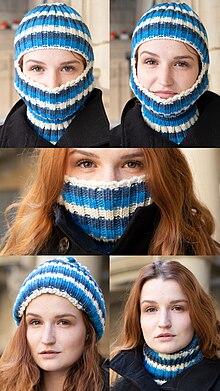Balaclava
Excerpt from Wikipedia, the free encyclopedia
A balaclava, also known as a balaclava helmet or Bally (UK slang) or ski mask, is a form of cloth headgear designed to expose only part of the face, usually the eyes and mouth. Depending on style and how it is worn, only the eyes, mouth and nose, or just the front of the face are unprotected. Versions with a full face opening may be rolled into a hat to cover the crown of the head or folded down as a collar around the neck. ...
History[edit]
Similar styles of headgear were known in the 19th century as the Uhlan cap worn by Polish and Prussian soldiers, and the Templar cap worn by outdoor sports enthusiasts.[4][5]
The name comes from their use at the Battle of Balaclava during the Crimean War of 1854, referring to the town near Sevastopol in the Crimea,[6] where British troops there wore knitted headgear to keep warm.[4] Handmade balaclavas were sent over to the British troops to help protect them from the bitter cold weather. British troops required this aid, as their own supplies (warm clothing, weatherproof quarters, and food) never arrived in time.[7] According to Richard Rutt in his History of Handknitting, the name "balaclava helmet" was not used during the war but appears much later, in 1881.[5] ...
Military and police[edit]
In the Indian subcontinent, balaclavas are commonly referred to as monkey caps because of their typical earth tone colours, and the fact that they blot out most human facial features. Monkey caps sometimes have a small, decorative, woollen pom-pom on top. They are commonly worn by troops on Himalayan duty for protection from the cold.[10]
The United States Marine Corps has recently begun issuing balaclavas with hinged face guards as part of the Flame Resistant Organizational Gear program.[11][12]
In the Soviet Union, the balaclava became a part of standard OMON (special police task force) uniform as early as the Perestroyka years of the late 1980s. The original intent was to protect the identity of the officers to avoid intimidation from organized crime. Because of increased problems with organized crime of the 90s, TV shots of armed men in black balaclavas became common. Armed Russian police commonly conduct raids and searches of white-collar premises (typically in Moscow) while wearing balaclavas. Such raids have therefore come to be known in Russia as "maski shows", an allusion to a popular comic TV show of the 1990s.[13]
Balaclavas are often used by police battling drug cartels and gangs in Latin America to conceal their identity and protect their families.[14][15]



Comments
Post a Comment